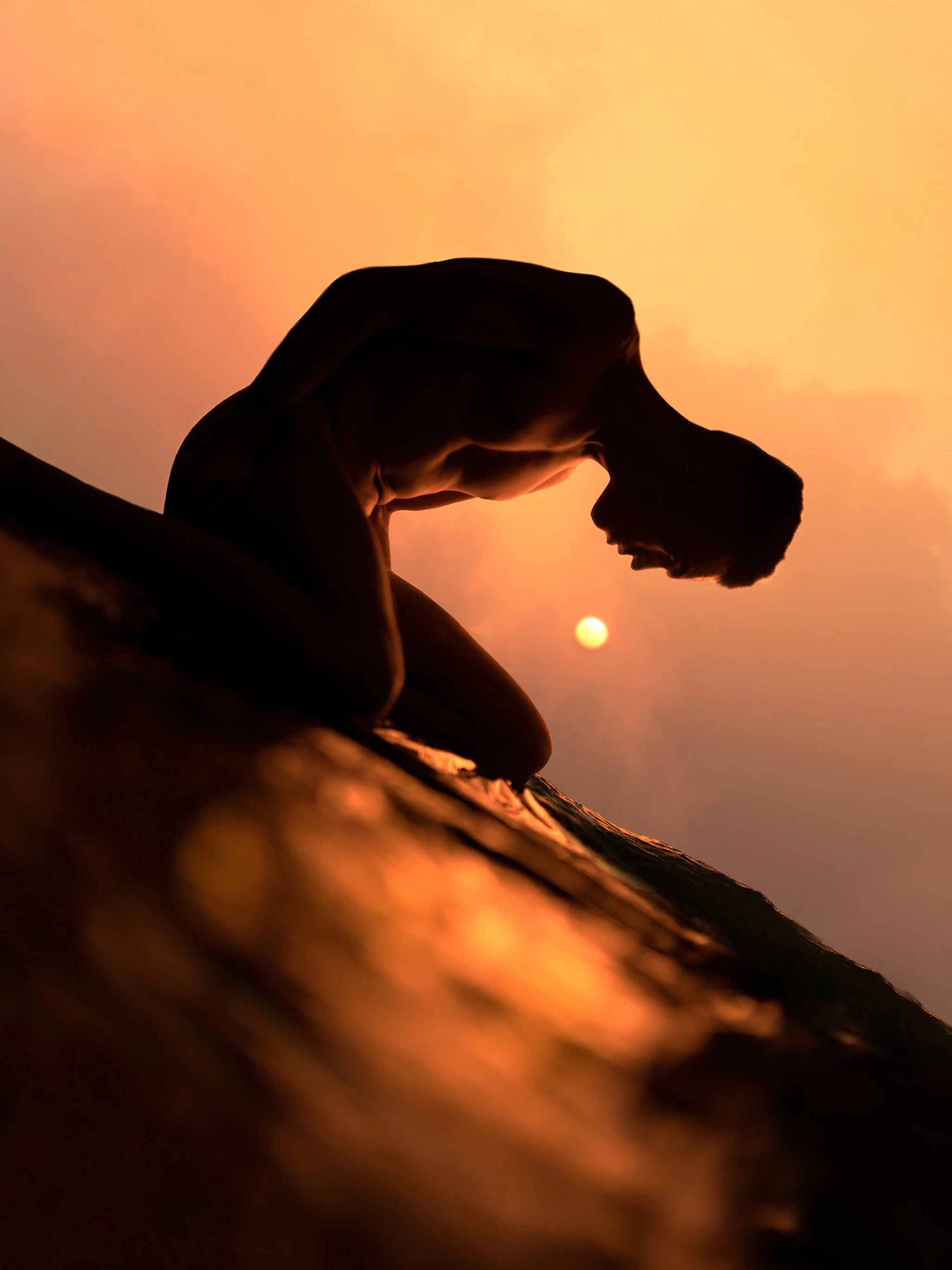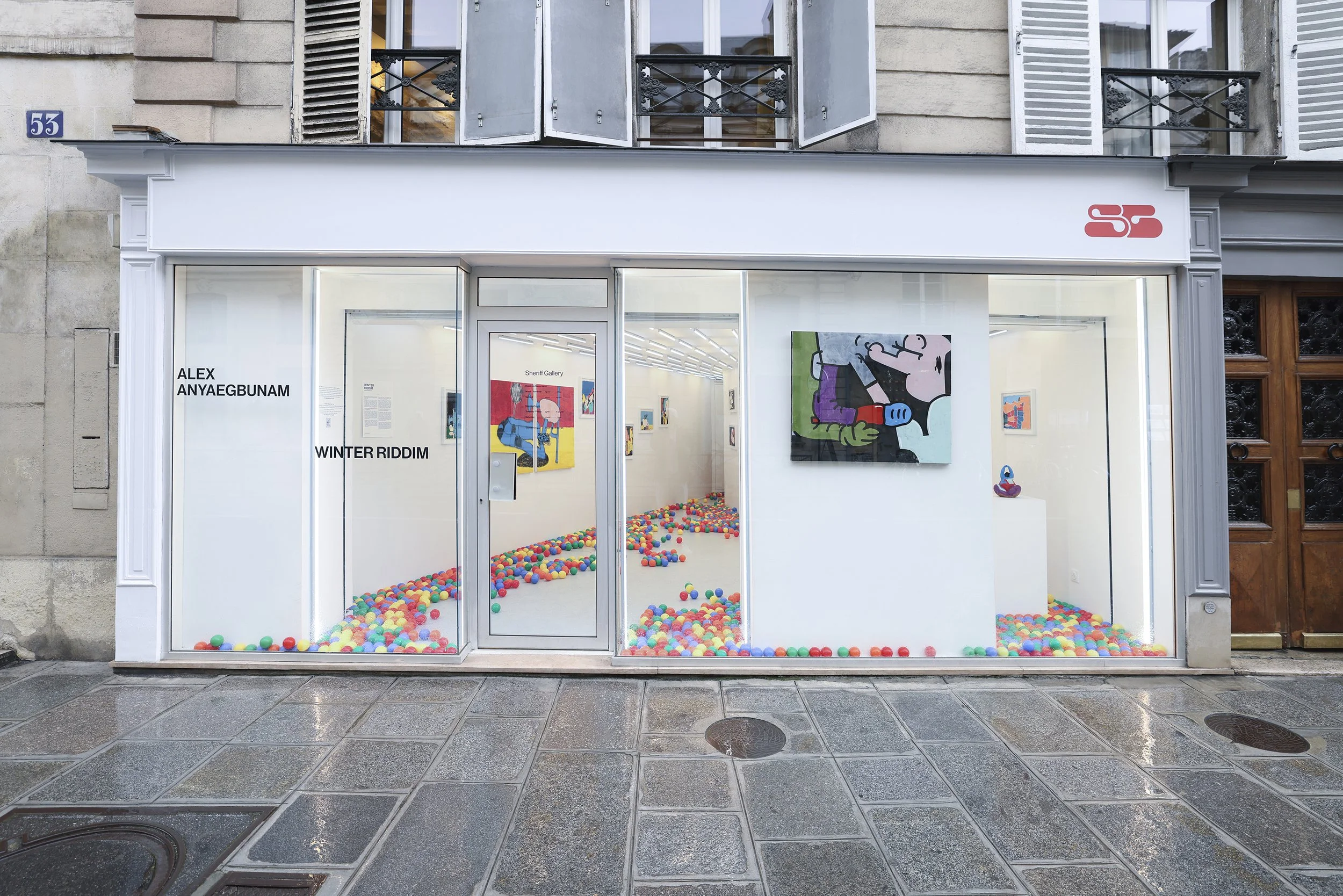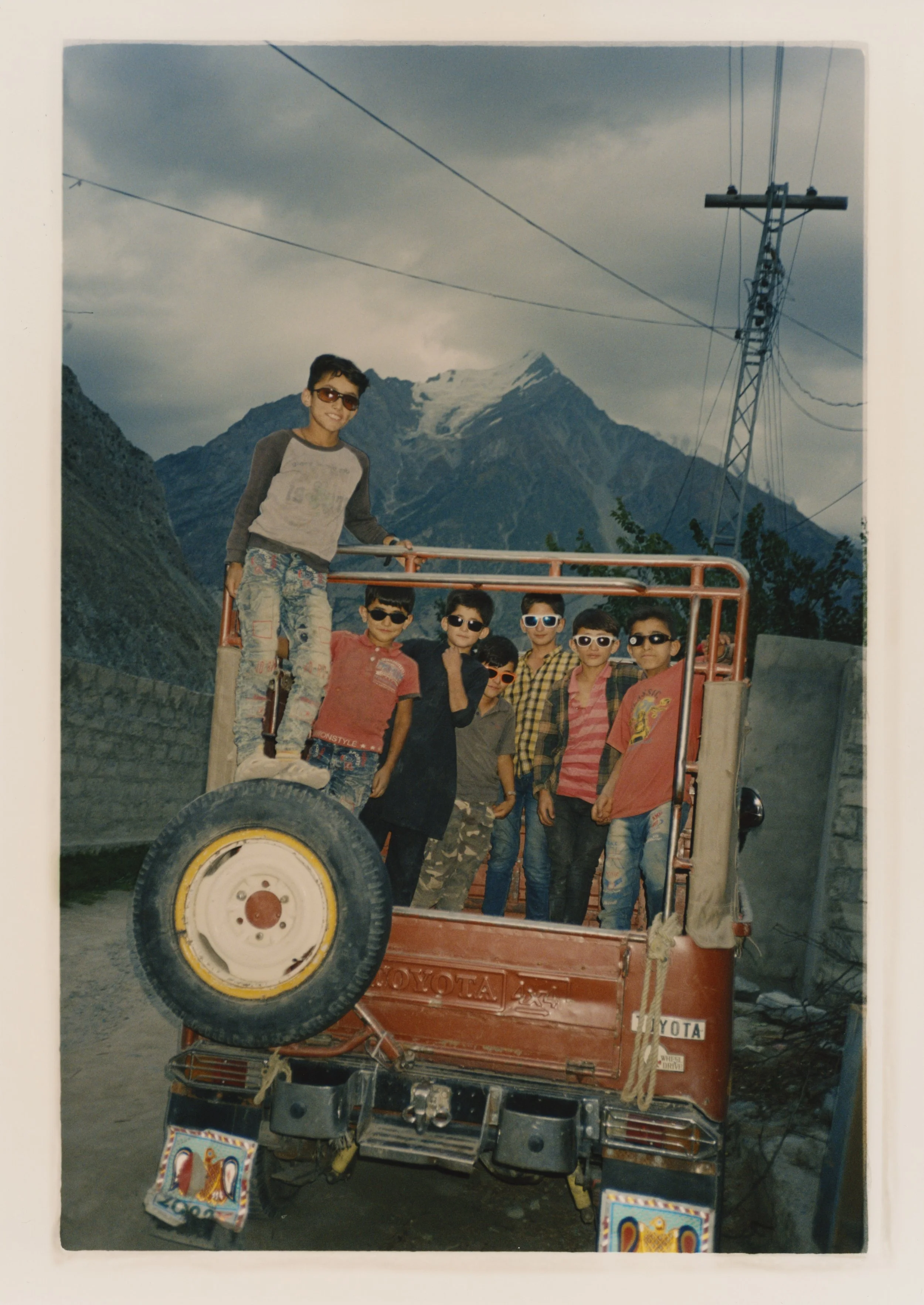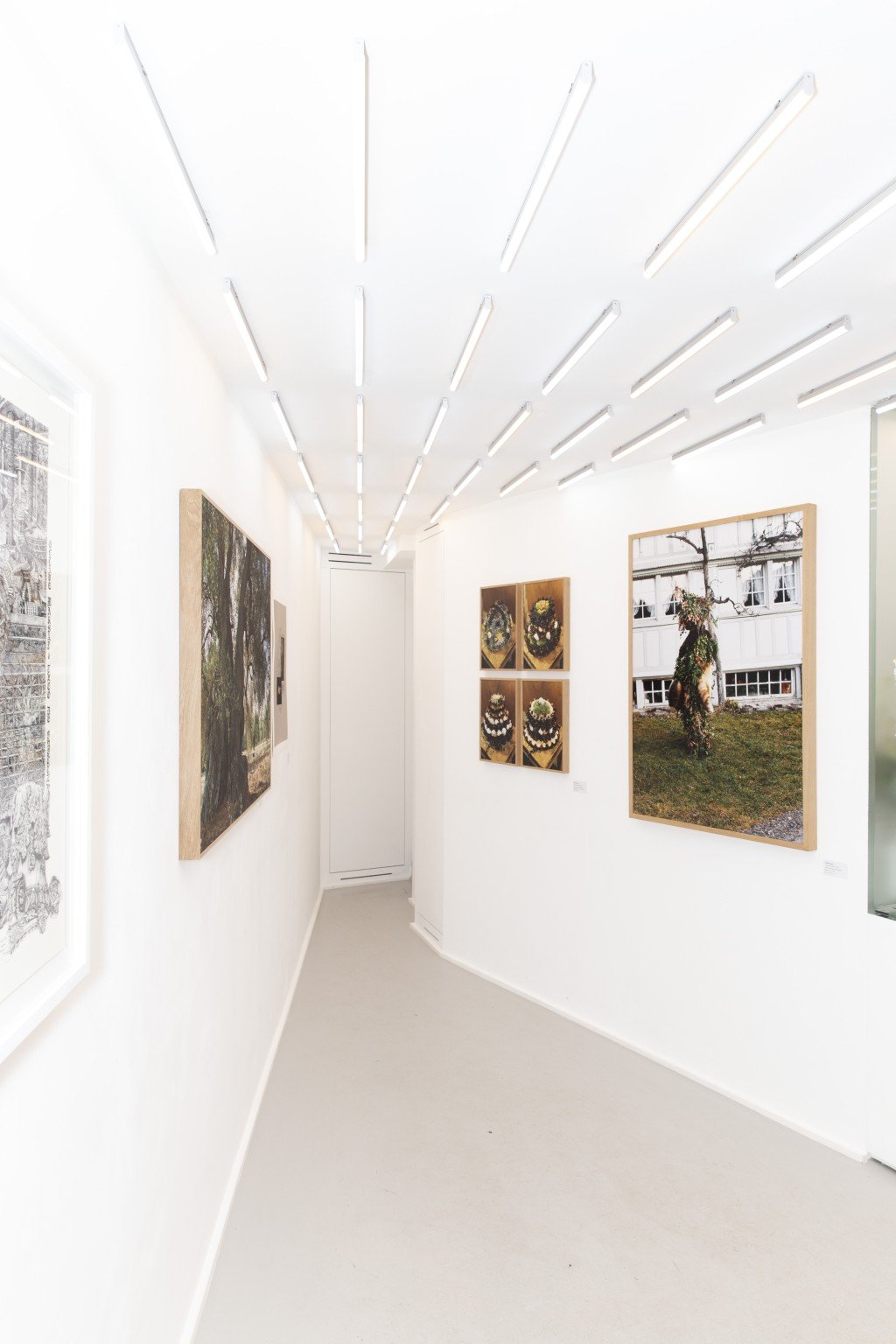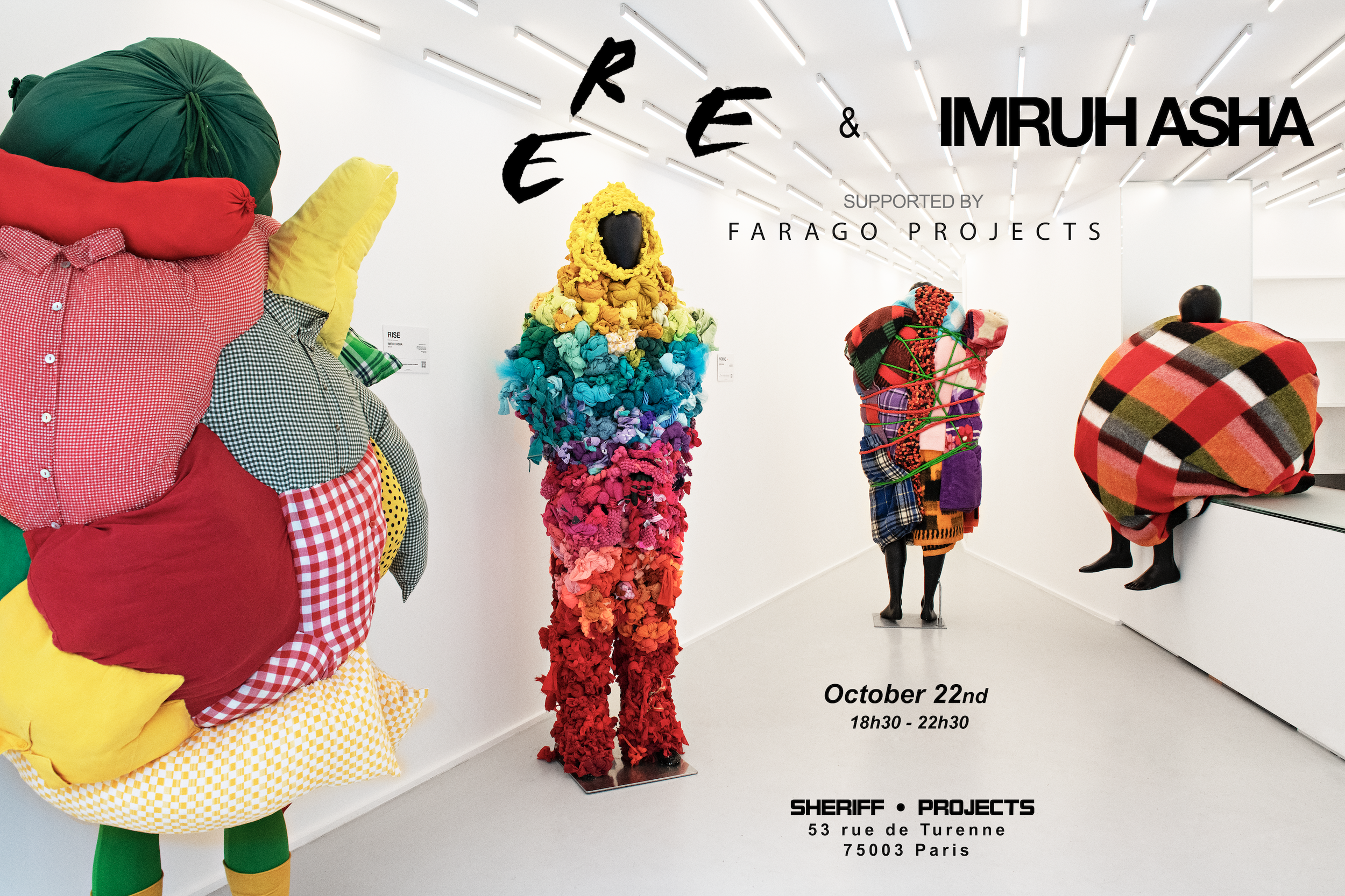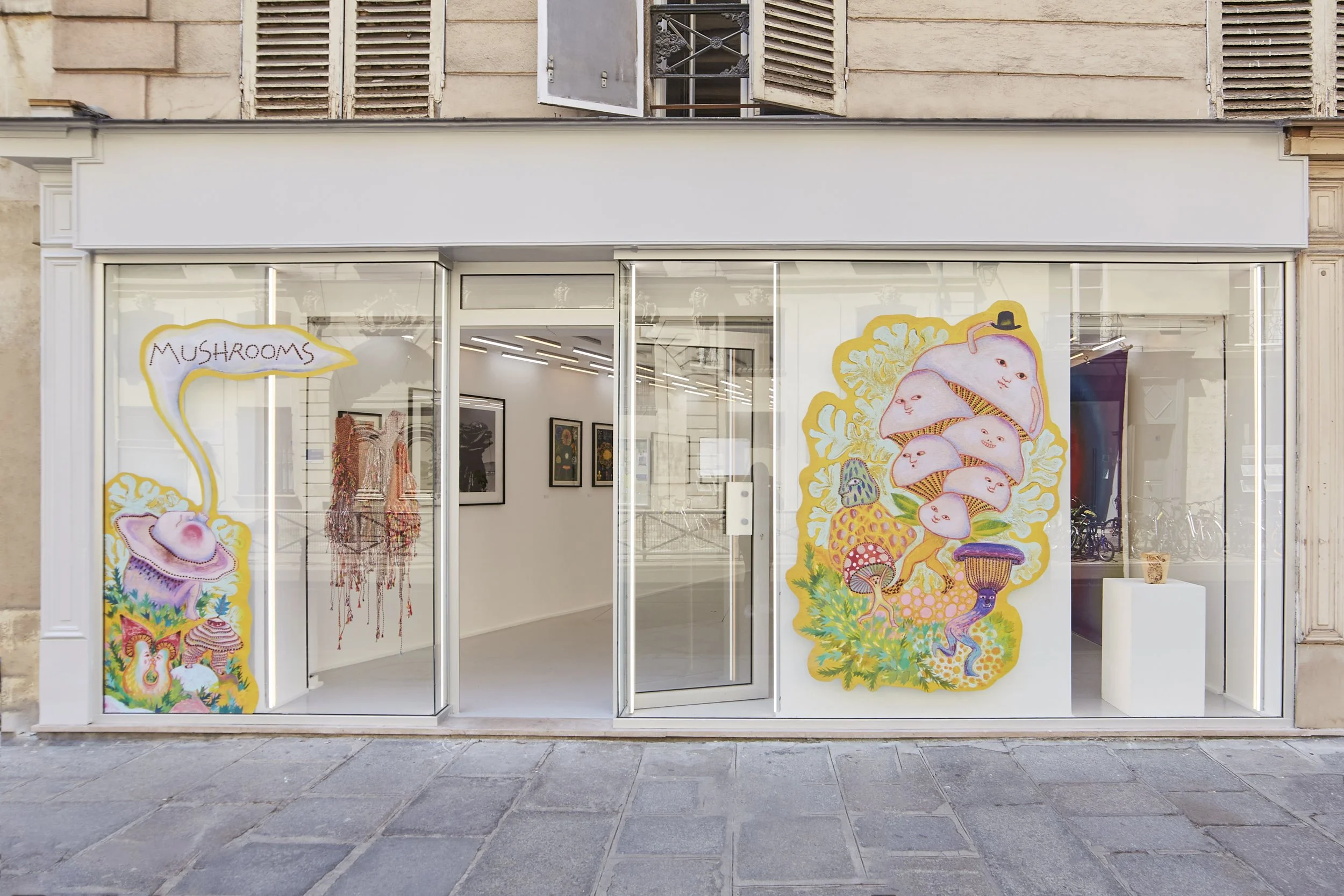November 2024 - January 2025
new suns
David Ụzọchukwu
The works in David Ụzọchukwu’s New Suns depict Black figures set within richly strange natural landscapes that might be the stuff of dreams or myths, from charred forests to mid- night-dark seas and saffron-coloured deserts.
By only situating Black bodies within such environments, Ụzọchukwu invites reflection on the historical marginalisation of people of colour from narratives of the natural world. In the Western imagination, territories such as ‘the frontier’ and ‘the wilderness’ have been sites of exploration or exploitation; virgin territory waiting to be conquered by settlers and adventurers. Black people, Brown people, indigenous peoples existed to be subjugated, enslaved or made extinct. Within fifty years of Christopher Columbus arrival in the New World in 1492, the Taino people of Hispaniola (present-day Haiti and Dominican Republic), who may have numbered up to eight million in population, had been virtually wiped out by diseases brought by Europeans such as smallpox, measles and malaria. The vulnerability of indigenous Caribbean peoples to infection was one of the signal factors in the beginning of the transatlantic slave trade, with Africans thought to be more resilient to disease.
For hundreds of years following the instigation of slavery, the relationship of Black people to land in the West was as labour. They were human animals made to work plantations and considered little more developed in their thinking and behaviour than other beasts in the field. In the 18th century Enlightenment thinkers like the Swedish botanist Carl Linnaeus theorised that humans were shaped by their environment. Temperate northern climes made Homo Europaeus into a ‘light, wise, inventor’. As a creature born of tropical conditions Homo Africanus, had a ‘flat nose; swollen lips’ and was ‘sly, sluggish, neglectful’. Linnaeus’ arguments laid the groundwork for future generations of ‘scientific’ racists, whose pernicious ideas about racial intelligence and hierarchy remain with us today.
Ụzọchukwu does not so much address these histories as suggest other possibilities for living. ‘There’s nothing new under the sun,’ observed the Afrofuturist author Octavia E. Butler, ‘but there are new suns.’ In his works, Ụzọchukwu transports us from the everyday into the speculative. Into realms of new possibility that rewrite the relationship between Blackness and nature. Here are Black bodies in the dark earth. Black bodies in the water and in the air. Black bodies crouching in the soil or flying in the sky.
Sometimes the sights he conjures are rhapsodic, such as the naked, glowing man floating through a rose-pink sky in Celestial Body, 2020. Other works carry intimations of apocalypse. Like the couple caught in a moment of tender closeness in Honey, 2022, they're headsbent together as they lean into a kiss, while behind them all is catastrophe. The earth is black and the sky is clouded and what looks like a shaft of molten lava is spouting from the ground. Perhaps this is an image of the end of the world. Thoughts of climate crisis and its disproportionate impact on nations and people of the Global South come to mind. But this might equally be a moment of rebirth. A creation myth in the making, just as Tectonic Shift, 2019, offers the Edenic spectacle of two lovers embracing against a verdant backdrop, like the first couple at the dawn of a new world.
To be Black in Ụzọchukwu’s pictures is to be connected to nature at a profound level of engagement and exchange. It is to be heir to a living planet. For millennia, peoples of colour around the world have conceived of the Earth in their myths and dreams and prayers as a lattice of species and systems. They have given it many names, as the scholar Donna Harway lists: ‘Naga, Gaia, Tangaroa (burst from water-full Papa), Terra, Haniyasu-hime, Spider Woman, Pachamama, Oya, Gorgo, Raven, A’akuluujjusi, and many many more.’
In Ụzọchukwu’s photographs we glimpse yet further modes of living in the world and living with the world. Other scenes of Black being. Other endings and new beginnings.
Ekow Eshun
David Uzochuwku with Galerie Gomis,
curated by Ekow Eshun
October 2024
BELONG
Aleksandra Orbeck
The Ju/‘hoansi San are considered to be the world’s oldest culture and have been carrying within them the wisdom of survival, adaptation, and profound connection to nature for well over 150,000 years.
“BELONG” is based on a long lasting conversation and relationship between artist and activist Aleks Orbeck and the Ju/’Hoansi San people of the Kalahari Desert. The exhibition enhances a poetic vision on the strength and sustenance of living in harmony with nature, without missing to be an urgent reminder of the ongoing erosion of cultural knowledge, indigenous language and belonging.
curated by Sophie Strobele.
They are our living ancestors, embodying the earliest chapters of human history and offering us a link to the origin of what it means to belong.
Curated by Sophie Strobele, BELONG doesn’t try to be a representation of a people, it is partly a reflection of the personal journey of Aleksandra Orbeck; partly a collection of impressions, moments and learnings from the culture of the Ju/’Hoansi. It’s far from complete and yet a humble invitation to start to understand the complexity of the Ju/’Hoansi - in a white Gallery Space, which couldn’t be harsher in contrast to the ways of living in the Kalahari. Nevertheless we hope to ignite your curiosity and share with you an internal and ongoing questioning and reflecting on ancestral belonging, through the eyes of Western contemporaries.
August 2024
THE WORLD ON BOARD
Skateistan started in 2007 in a derelict fountain in Kabul, Afghanistan. Today, they are operating in over 20 locations worldwide and saw 211,729 participation last year alone. Their sister organisation, The Good Push Alliance, brings together nearly 1,000 social skate projects across the globe. In this exhibition is a series of photographs taken by friend of Skateistan, Juliette Cassidy.
March 2024
WINTER RIDDIM
ALEX ANYAEGBUNAM
Step in, sit and play, surrounded by the visual alphabet of multi-disciplinary artist Alex Anyaegbunam, born in Ireland in 1993.
Images always come first – whether it be in film or music, where Alex is celebrated for his sounds and lyrics under the stage name Rejjie Snow. The act of songwriting starts with visual thinking. Images are building blocks, constructing a world of their own. Making marks – lines and shapes – is the start of making meaning. It is a way of exploring and understanding our world and communicating ideas, without linguistic connotations or limitations.
The limits of my language mean the limits of my world’, to quote Wittgenstein.
Alex Anyaegbunam resists being defined by or confined to one activity or another. Whether it be music, painting, design or fashion, Alex diligently pushes the boundariesof the expected. Informed by graffiti, where the streets provide the canvas and precision is key, his debut show in Paris doesn’t shy away from making a bold statement. The mixed media paintings on show proclaim a new language, a new world, a vocabulary that stands strongwith no need to prove itself.
As spectators we are comforted in a joyful, naïve andperhaps illusionary world. Unexpectedly, this playful world lays bare fields of psychological depth and tenderness. We feel like children for a moment. Like children, whose keen sense of the world is so often belittled by cute words, soft balls and bright colours. The question being how comforting all this actually might be.
January 2024
Cornelius Kaess, Sebastian Berthold
“The cock crowing in the milky dawn thinks its call raises the sun; the child howling in a closed room thinks its cries open the door. But the sun and the mother go their own way, following the laws of their beings. Those who see us, even though we cannot see ourselves, opened the door for us, answering our puerile calculations, our unsteady desires, and our awkward eorts with a generous welcome.”
René Daumal, Mount Analogue
The traveling eye of photographer Cornelius Kaess witnesses a warm welcome towards visitors of a foreign place and a simple gesture of offering in response. He captures an encounter, an exchange, an intercultural connection. Eye to eye, hands being shaken, important gifts distributed and smiles exchanged.
Since 2009, the non profit organization SHADES OF LOVE has distributed hundreds of thousands of sunglasses to the world's most remote high-altitude regions, providing essential eye protection and awareness to alleviate the overlooked and perpetual problem of altitude blindness. The people living at 2500-3500m altitudes are exposed to incomparably harmful UV radiation, which due to lack of eyecare, causes up to 80% of the local people to suffer from eye disease and blindness.
Traveling through the stunning Hunza Valley in North Pakistan along the border with Afghan Nuristan, also called the “land of light”, the team of SOL engages in a simple but effective initiative. Taking sunglasses out of the cosmopolitan context and distributing them among the high peaks of North Pakistan, gives these sunglasses an essential role: both as crucial eye protection and connective gestures. The distribution trips offer rare insights into these spectacular regions, home to colossal summits, ancient history and a rare tapestry of cultures.
October 2023
IN/VISIBLE
IN/VISIBLE is a collaboration between Soul Food, ERE Collective and Sheriff Projects. A fundraiser, group show and a series of cultural excursions, this project allowed young Soul Food members the time and resources to extensively explore the art of photography.
Over the course of the year, 5 young Soul Food members worked with 8 professional photographers and went on multiple photo-based excursions, including a museum visit, street photography and portrait workshops, as well as a visit to Sheriff Art Lab where they gained insights into the processes of printing and retouching fine art images. They were also given disposable cameras and asked to take photographs of their everyday lives, of things that inspire them, rendering the invisible visible and the banal beautiful.
The accumulation of these creative encounters is IN/VISIBLE, a collective photography exhibition including work by the photographers and young Soul Food members involved. It highlights the universal possibilities of art to render visible the human aspects of migration, the importance of cultural diversity and the limitless potential of positive integration.
Térence Bikoumou, Mathias Depardon, Fatoumata Diabaté, Kevin Felicianne, Bettina Pittaluga, Cédrine Scheidig, Wendelin Spiess, Charlotte Yonga.
December 2022
I-M-A-G-I-N-A-T-I-O-N-S
Rala Choi, Adeline Care, Maya Agam, Charlotte Collet, Théo De Gueltzl, Linus Gruszweski, Lesya Godfrey, Larissa Hofmann, Alice Jacobs, Mila Taylor Young, Moffat Takadiwa, Marisca Voskamp Van Noord.
Imaginations presented a selection of original art installations, curated by Sophie Strobele, who invited international artists to create with limited materials and resources. Instead of using virgin materials for their artworks, the participating artists rethought the forms of used materials, sourcing their materials at recycling centres and dump sites. imagination is the human faculty of progress, of creation, of care. it is the opposite of neglect, it is the chance to create beyond the conditions of the given.
The young creation of today acts in a paradoxical environment of unsustainable excess and impending scarcity. As the common perception of disposable goods slowly shifts, the exhibition at present was an opportunity to question our relationships to materials. The exhibition showcased a blooming field of imagination and reflection that demands the relationship between waste and newness to evolve. imagination is an invitation to imagine a future that is resourceful, fair and ingenious.
November 2022
ENATY
Mysticism is a crucial source of collective power and collective identity, fronting a globalised, colonised and industrialised world. In the village of Djimande, in Casamance, mystical constructions and traditional belief based on animism are still being practiced in close symbiose with the environment. Photographer Charlotte Lapalus, who joined ADE six years ago, has since been collaborating with the people of Djimande - especially women - to create a visual journey into the sacred world of this wondrous place in Casamance.
Autour de l’Enfant, Benjamin Grillon, Charlotte Lapalus.
MOKORO
Kristin Lee-Moolman, Louise Ford and Warembo Wasanii
The Warembo Wasanii art studio in Nairobi’s Korogocho area is a visual feast. Hanging on walls are garments in various states of creation. are beer can and clear straw headpieces, a bouquet of plastic cup daffodils, a green pleated skirt made from gunny bags, flattened bottle tops, wild tendrils of computer and charging cables, potted plants and many other odds and ends. It is chaos in order, a sanctuary created by Kenyan artist Joan Otieno for many young women in her community. For the past four years, Joan has taught her female students how to create intricately designed garments and artworks by upcycling plastic polymers sourced from the nearby landfills of Kariobangi and Dandora. The labor involved is self-evident, as is the talent. In their hands objects destined for slow degradation are reimagined and transformed into sculptural ensembles consisting of matching fashion, footwear and headpieces, whimsical, and expertly crafted.
Her students’ & their their garments are the focus of Mokoro, a collaborative multimedia exhibition debuting at Gallery Mercier et Associes in Paris this June. The body of work celebrates self-empowered women, creativity, and sisterhood. Staged in all their strength and beauty, the girls of Warembo Wasanii stand tall as monuments to each other. Mokoro Meaning ‘mother’ in sheng, the word Mokoro reflects the artistic refuge women can create for each other, just as Warembo Wasanii has created for the girls of Korogocho. A space where new concepts, progressive ideas and personal stories can be shared in a protected environment. Each upcycled garment is made in solidarity: once someone picks their chosen material, may it be plastic straws or bottle caps, all girls will dedicate time sourcing that material for their creative sisters.The visuals of Mokoro, portraying the girls and their artworks were created by the duo of stylist Louise Ford, and photographer Kristin-Lee Moolman, Featuring hair stylist Yann Turchi and curators Emmanuelle Atlan (Farago Projects) and Sophie Strobele (ERE Foundation). It was Louise and Kristin-Lee who first presented the concept and commission to Joan and Warembo Wasanii. In Kenya in 2019 to produce, 28 HATS FOR LAMU–a series of images documenting the competitors in the Shela Hat Contest, a biannual event in which entrants created hats from material that would otherwise be thrown away–the pair quickly fell in love with the work Joan and the girls were doing. They then spent a year marshalling resources and assembling the right team to bring Mokoro to life. This included Sophie Strobele, co-founder of ERE Foundation, a French-based philanthropic organisation started in response to a demand for accountability from creatives in the fashion industry. “We favour projects that are impactful and positive, while being creatively convincing. And this project just reunited all of that. There was a creative intent connected to a cause,” she says. Sophie collaborated with Emmanuelle Atlan from Farago Projects, a creative production company, specialised in the fashion industry, that has been offering its services to support creative teams through special projects such as Mokoro.
Parallel to the exhibition, ERE Foundation and Farago Projects are working to supply long term support and exposure to Warembo Wasanii, assisting them in developing their skill sets and laying groundwork for future collaborations with fashion houses and other creative spaces. And as for the November 2021 shoot that finally made Mokoro a reality, Louise shares, “It was a true team collaboration, Kristin scouted for locations around the Atelier and throughout Nairobi, finding unique settings to build the world of Mokoro .Yann addressed each outfit in question and to understand how each girl felt about her hair. The girls were always closely escorted by Joan, translating Kristin’s movement directions when necessary and making sure they felt comfortable and confident. Emmanuelle and Sophie accompanied us on the shoot, interviewing Joan and the girls to fully understand the extent of this project and tell the story in all its strength,” says Louise, who grew up between Zimbabwe and Kenya and whose art direction and styling work shine through the project.
Presented by: ERE, Supported and Produced by: Farago Projects, Photography + Video: Kristin Lee-Moolman, Art Direction + Styling: Louise Ford, Hair: Yann Turchi, Artists and Talents: Joan Otieno and members of Warembo Wasanii Art Studio: Nzelani, Risper, Lourine, Marion, Barbara, Rose, Brenda, Idah, Vero, Amina, Wanja, Nancy, Phanice, Emma. Creative Direction: Kristin Lee-Moolman, Louise Ford. Exhibition commissioner: Sophie Strobele. Curated by: Emmanuelle Atlan and Sophie Strobele. Writer: Wanjeri Gakuru
June 2022
MORIA
Evolving around this thought, the group show unites a diverse body of art works, which demonstrate the significance and sacredness of trees through different angles and ways of storytelling. The curation explores the question whether trees and their ecosystems should bear legal rights, as it was the case of the Moria trees, protected by the state due to their sacred character.
As part of a series of philanthropic, ecologically engaged group exhibitions at Sheriff Gallery, “MORIA”, curated by Sophie Strobele, unites an eclectic body of artworks, visually manifesting the significance and sacredness of trees. Challenging anthropocentrism viewpoints, ‘MORIA’ celebrates trees as symbols for symbiosis and collaboration; acknowledging their sensory abilities, communication skills, climatic influence, and spiritual significance.
In Ancient Greece, the concept of MORIA recognized olive trees as sacred and strictly protected by law. To uproot a Moria tree was a punishable offense. Today similar thought constructs exist in the example of the Rights of Nature Movement. Such a radical paradigm shift claims that an ecosystem has the fundamental right to exist, flourish and regenerate its vital cycles without human-caused disruption. Therefore writing a story, in which nature is centrally placed and humans are connected to the environment in an interdependent way, rather than a dominant one.
The visual kaleidoscope takes the visitor from an utopian futuristic society constructed by Theo De Gueltzl and Octave Marsal called Moriapolis, to Lena C. Emerys meditation on our intrinsic connections to nature through mind, body and matter. A thousand-year-old olive tree, captured at the Westbank by Nick Waplington, is opposed by a representation of the holistic presence of trees in indigenous belief systems in the form of a drawing by Tahuanty Jacanamijoy. A dragon blood tree, close to extinction, on the Island of Socotra, is juxtaposed by visions of the Amazon Rainforest through the lens of KAO and Pedro de la Fuente. Estelle Hanania captures tree-like costumes in the Swiss Mountains, while Hans Neumann allows an intimate insight into his cohabitation with sacred olive trees. Laurence Ellis documents a cloud forest of Veracruz, where a cooperative of women protects a forest regrowth without any human intervention. In the Dannenroeder Forest in Germany, Joachim Mueller-Ruchholz documents protesters that have taken to the trees of the forest itself, living for the past year in homemade treehouses, resisting eviction, and battling against the government.
Curated by Sophie Strobele, the group show manifests trees in their sacred existence as symbols of life and shelter: ‘MORIA’ and the participating artists supports ‘Canopée’, an association mobilizing citizens for the protection of forests, as well as ‘Now you see me Moria’, a creative collectif engaging for humane living conditions in refugee camps like camp Moria, on the island of Lesbos.
March 2022
PTASHKA
Baby Production, ERE Foundation, Artissue Gallery, and Sheriff Projects initiated an exhibition and print sale of 31+ images (years of Ukrainian Independence) for Ukraine, solidarity, freedom, and peace.
The exhibition « PTASHKA » supported the organisations « Better Community » « Palianytsia » and « Kyiv Angels » to support Ukrainian population in times of war.
February 2022
What About Us, Honey?
As part of a series of philanthropic and ecologically engaged group shows, «What About Us, Honey?» invites into the sphere of pollinators.
Inspired by the symbiotic relation between bees and flowers, the exhibitions intends to open a dialogue on the relationship between humans and the environment.
The observation of the natural world and the symbiotic relations present in such, frame the here presented works: where the artists express their personal perception of eco-systems and their complexity. «What About Us, Honey?» intends to sensitise the public on sensorial, emotional, cognitives, physical and spiritual level. Finally emphasising our existential dependence on pollinators and symbiotic, interdependent relationships. All proceeds of this group show are shared between the artist and POLLINIS, an NGO fighting against the extinction of bees and other pollinators, on who our entire biodiversity depends on.
Andrey Zouari, Carolina Aguirre, Constance Valero, Io Burgard, Maewenn Bourcelot, Malik Jeannet, Morgane Tschiember, Samuel Fasse and Karina Rikun, William Farr.
November 2022
HOPE
Letter from photographer Stefan Dotter
“Art and especially photography are the enemy in any extremist-led Afghanistan. We, as a community of artists have come together to support photographers in Afghanistan. Photography as a mean of self-expression and documentation is particularly essential under these circumstances and will help preserve the cultural diversity of Afghanistan“.
Together with photographer Stefan Dotter and activist Sabrina Herzog, ERE Foundation has united the work of 100 engaged photographers around a print sale, dedicated to the evacuation and resettlement of 8 Afghan photographers.
HOPE featuring the work of
Juliette Abitbol • Mathilde Agius • Danielle Alprin • Philippe Arlt • Alina Asmus • David Avazzadeh • Tess Ayano • David Baum • Edgar Berg • Kristin Bethge • Anthony Blasko • Jeff Boudreau • Anna Breit • Brendan George Ko • Kira Bunse • Juliette Cassidy • Kevin Castanheira • Ali Kate Cherkis • Lee John Clayton • Lauren Coleman • Volker Conradus • Elaine Constatine • Laura Jane Coulson • Elena Cremona • Matthieu Croizier • Jack Davison • Katrien De Blauwer • Quentin De Briey • Théo De Gueltzl • Max Dorsogna • Stefan Dotter • Laurence Ellis • Brad Elterman • Phil Engelhardt • Daniel Etter • Peter Fisher • Jermaine Francis • Maria Johanna Fritz • Daniel Gebhart de Koekkoek • Vitali Gelwich • Gavin Green • Luca Grottoli • Marie Haefner • Amanda Hakan • Estelle Hanania • Jamie Hawkesworth • Alyssa Heuze • Hill & Aubrey • Alex Huanfa Cheng • Larissa Hofmann • Carlijn Jacobs • Drew Jarrett • Jesse John Jenkins • Tom Johnson • Jack Johnstone • Kinga Katanics • Marc Krause • Adam Kremer • Dylan Kronen • Brendan George Ko • Charlotte Lapalus • Robbie Lawrence • Chloe Le Drezen • Massimo Leardini • Lucas Lehmann • Crista Leonard • Wai Lin Tse • Thomas Lohr • Sasha Marro • Maddy Minnis • Joachim Müller-Ruchholz • Nikki McClarron • Katsu Naito • Charles Negre • Hans Neumann • Ina Niehoff • Zhenya Posternak • Remi Pujol• Mafalda Rakos • Jody Rogac • Alice Schillaci • Yannick Schuette • Sednaoui Stephane • Maximilian Semlinger • Emine Sevim • Laila Sieber • Flavia Sistiaga • Alec Soth • Mika Sperling • Charlotte Stouvenot • Julien T Hamon • Tajan Sophie • Marius Uhlig • Jonas Unger • Cyrille de Vignemont • Massimo Vitali • Alexandra Von Fuerst • Farzana Wahidy • Eddie Wrey • Watkins CG
October 2021
FUTURE SHOCK
Imruh Asha, Erefoundation, Farago projects, Clothes sourced at Relais Val de Seine.
ERE Foundation invited Imruh Asha to create a series of textile sculptures made from disposed clothing, provoking an important conversation amongst the fashion industry. The exhibition « Futureshock » raised funds for The OR Foundation, to support their fight against textile pollution in Ghana.
June 2021
MUSHROOMS
Ghislaine Herbera, Ibby Nijoya, Jazz Grant, Katie Scott, Maurizio Montalti, Samuel Bradley, Tang Tsung Chien.
The exhibition opened with a group show curated by Sophie Strobele, featuring multi-disciplinary works of eight international artists around the theme „Mushrooms“, whose artistic approach and practice revolves around, with or alike mushrooms.
When one tree struggles, the other trees send nutrients to sustain the harmed tree through the web of mycelia connecting roots between each other.
Inspired by mycelium, nature’s intelligent web of communication and its fertile body, mushrooms, the show intends to emphasise the interconnection between creatives in the art space, hidden or visible, one nourishing the other.
Fungi’s power of transformation and regeneration positively affects our perception of decay. Through decomposition we transform the past, creating a base for new beginnings, while integrating and learning from what’s behind us.
From colourful illustrations, over botanical depictions, documentary photography, clothing design, collages, painting, bio-fabricated objects and an interactive video, the chosen artworks embody solidarity, regeneration, new materials, decomposition and transformation. Drawing a parallel from nature’s design and the mycelium interconnecting all organisms, this exhibition intends to invite a transition from passive display or consumption of art to support of and amongst artists, growing a long lasting relationship and generating
positive change. As well as shining a light on fungi’s incredible potential in bio-fabrication and alternative to conventional materials.
